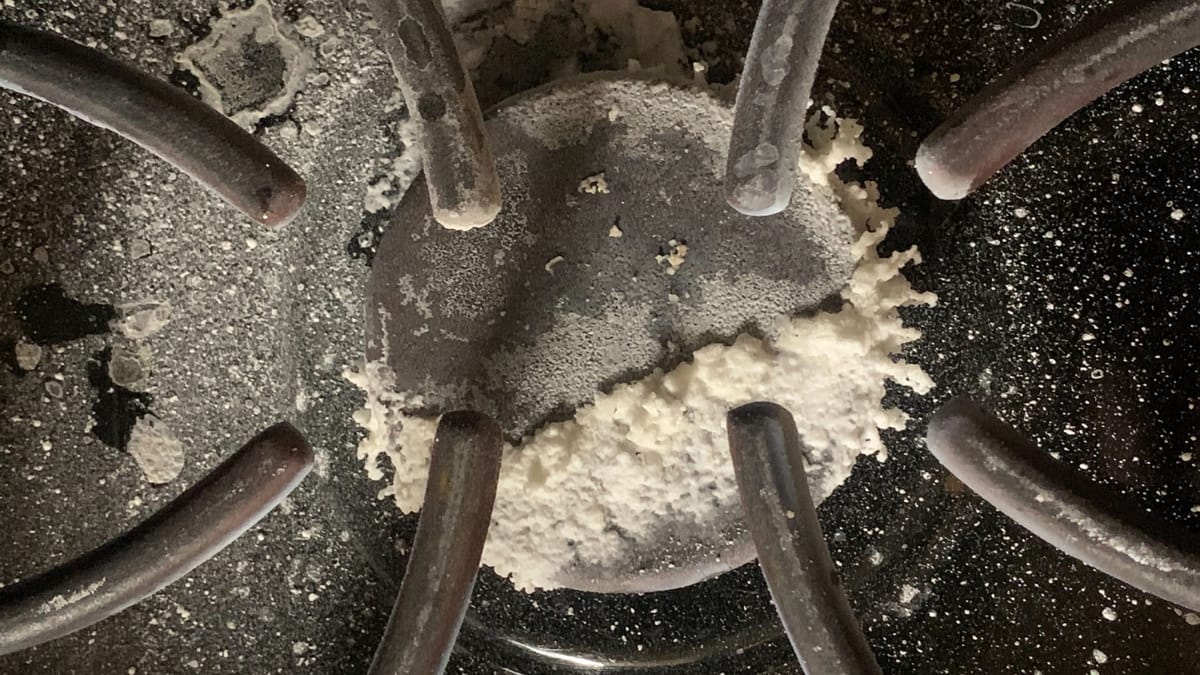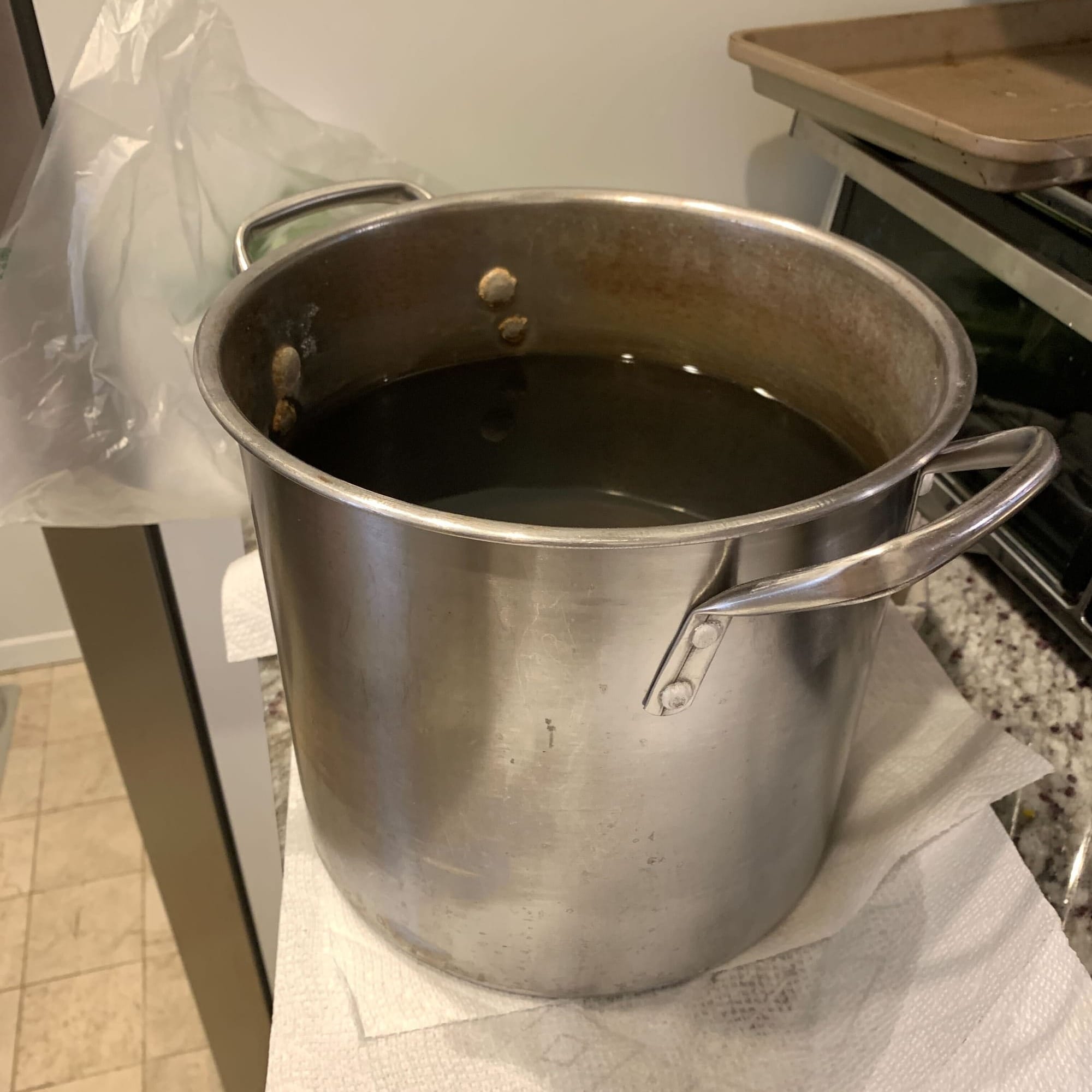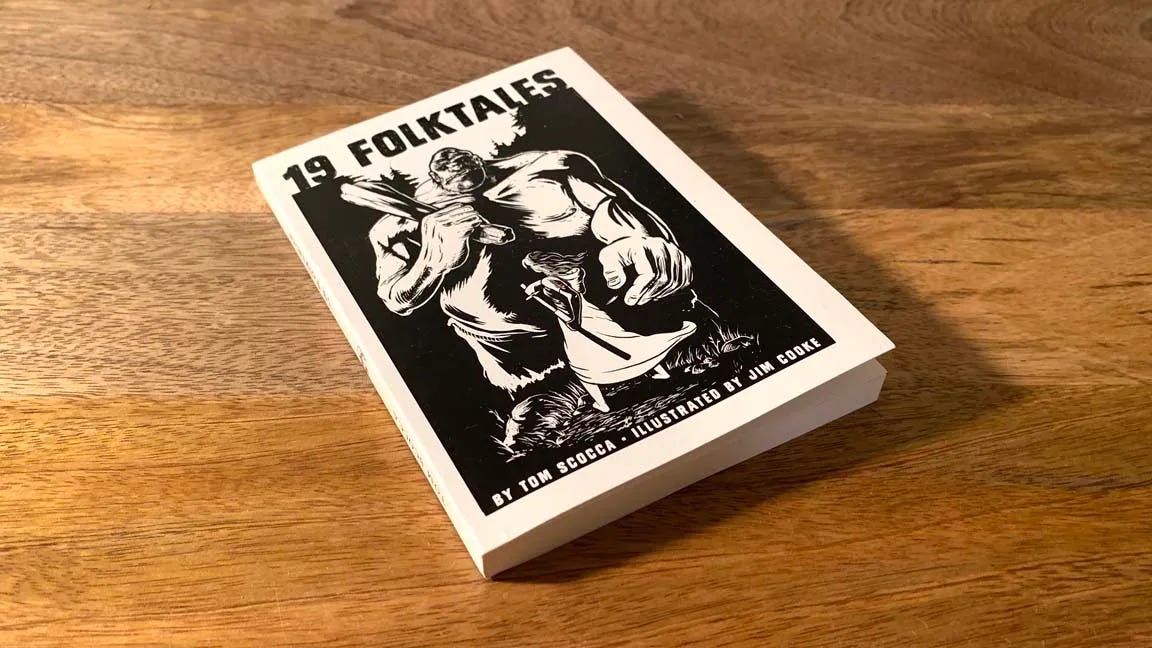Food Friday: The kitchen routine springs a leak.
Indignity Vol. 4, No. 72

DISPOSSESSIONS DEP'T.
Dispossessions: The Pasta Pot
IT STARTED AS normally as it could possibly have started. I filled the pasta pot with water, plopped it on the rear burner, and added an overflowing handful of salt, the way I'd done let's say twice a week, on average, every week, for 30 years. Three thousand times, more or less? Not counting jiaozi, or Ukrainian dumplings, or the broccoli rabe for blanching, after which the green water gets dumped out and a pot of salt water goes back on the burner. I put the lid on.
As I focused on the rest of making dinner, though, the stove kept catching my attention. The burner was roaring, and the flames, jumping along with the roar, were yellow, as if the pasta were already in the pot and boiling over. I looked more closely and saw some evaporated salt-spatter on the top of the stove.
Somehow, I guessed, the water on its way to boiling must have agitated itself into some odd harmonic frequency, rattling on the stove grate until it sloshed out. I adjusted the pot on the burner and lifted the lid. The water was flat and placid, no more than lukewarm.
There really was a lot of salt on the stovetop.
The burner was still hissing and flaring. Through the golden flames, which ought to have been blue, I saw that the burner cap was thickly encrusted with salt, lumpy with it. Branching protrusions—little tentacles of salt—reached out from it, poking into the air. I turned off the burner.
Clearly, the salt water had been getting onto the stove. And if it wasn't coming out the top of the pot, it must have been—
EXCLUSIVE VIDEO
I lifted the pot off the stove, hefting its old, familiar weight, and set it down on some paper towels on the counter. I waited a bit, then picked it up. The paper towels were wet.

I got out the bigger, less-used pasta pot and dumped the salt water into it. There was a time, in my mid 20s, when the everyday pasta pot went into eclipse. I was living in apartments with crappy electric stoves back then, and it took forever to get the water back to the boil when the pasta went in. The greater the volume of water, the less effect a pound of room-temperature dried pasta would have on the overall temperature. Staring into the steaming, non-boiling water with the pasta soaking in it, I daydreamed about larger and larger capacities; years later, when the problem was long moot, I still would catch myself staring in restaurant-supply-store windows at the three-foot-tall pots.
Once I was on gas burners, the more compact pot returned to its leading role. It was lightweight stainless steel, easy to manage, all the pot I needed. I never had to think about it.
Now I was inspecting it, holding over the sink. Down at the bottom, in the scratched and battered depths, I saw—did I?—yep: a tiny speck of light. No, two tiny specks, one bigger than the other, the wide-set glowing eyes of some lazy cartoon monster. I ran some water into the pot and held it up, to inspect it from below. A bead of water swelled on the steel and dripped down. Another droplet grew to take its place.

The pot was leaking. My pot. Was leaking. I could not—cook—pasta?
—In my pasta pot?
My pasta pot! My parents sent me out into the world with it. It was the oldest surviving piece of my kitchen equipment. I had solved, rationally, the puzzle of what was going wrong on the stove, only to replace it with an irrational mystery. The pot was always there. The pot was no more.
Fleetingly I imagined some kind of tinker beating metal patches over the holes. Maybe the place up on Broadway with the signs saying they do typewriter repair and notary work? No. Not plausible, and even if it were, the result would not be my pot. My pot didn't have patches on the bottom.
My pot, the pot I depended on, didn't have holes in the bottom, either. The nagging sentimental urge to hold onto something familiar was barely even there. I checked the barely legible mark on the bottom—STAINLESS STEEL/THAILAND—and then got the measuring tape out of the junk drawer and took down the measurements: about 9 1/4 inches from outer lip to outer lip, and about 8 1/4 inches tall. Then I set it down by the recycling.
I didn't even notice when one of the kids took it down with the trash in the morning. I had abandoned the physical object. I had the mental image and the set of numbers. Pi times the radius squared times the height would mean eight quarts or so, though I had no idea whether people selling cookware defined the volumes to the rivets or to the brim or what.
Already, I knew I was in trouble. A little light online searching confirmed that I was in the old frustrating situation of trying to match a cheap, simple object that nobody else really cared about the conformation of. There were eight-quart pots that were short and wide, nine-quart pots, pots with silicone handles or aluminum handles, pots with strainer inserts and steamer attachments, pots with induction-ready steel/aluminum multi-ply construction.
Lots of what I could find were stockpots. I'd made soups in the old pot before, especially before I had other options, but it was a bad stockpot—narrow and crowded for stirring, with a sharp corner where the sides met the bottom, and with metal so thin it was liable to scorch. What it was good for was boiling water.
Logicially, I don't need a pasta pot in that exact form. The spaghetti just has to be a hypotenuse, right? A seven-inch-tall pot with a ten-inch mouth should do about the same job, geometrically, as the eight-ish by nine-ish version, but cooking spaghetti in something low and wide feels wrong. I could spin the spaghetti out radially flat on the bottom of the 11-inch-wide Dutch oven, too, but I wouldn't.
The internet was not going to tell me what I needed. I took the subway to Zabar's and wandered the aisles upstairs, looking for the echo of the right physical form. There was something almost the right shape, but it was the bottom component of a $350 couscous cooker. There was another pot that nearly looked right, except the handles stuck out too far and it was much too sturdily built. It might never spring a leak, but judging by my old pot, that advantage wouldn't make a difference for another thirty years, by which time I'd be over 80. And who wants to sling around a pot that heavy, at that age?

WEATHER REVIEWS
New York City, April 25, 2024
★★★★ The number on the weather app, a 47, seemed impossible to reconcile with the high, inviting sun outside. Nevertheless, a few steps out the door and the heavy hoodie had to go on over the t-shirt. The foliage was losing its early delicate yellow but the green was still pale. The ball fields had lost their red flags, the wire fence had been opened, and far off in the lush junction of one shallow outfield with another deep outfield, children were shrieking and chattering under adult supervision. Another group of children, in matching red t-shirts, came shouting through the fence on the far side. Ahead of them a grownup dropped first base onto the bare dirt. The dead leaves still trapped behind construction fencing were withered to the limit, dull as ashes. In the medical center, the tall glass lobby wall was working like a greenhouse. Afternoon was still cold—cold enough for the chill to be a plain, acceptable fact, not a creeping, half-established discomfort. Flies, countless gleaming files, spewed with a buzz and a rattle from the flourishing, jaundice-yellow leaves of a shrub at the corner, then settled back in again.

EASY LISTENING DEP'T.
This first rectangle, below, is the podcast file right here on GHOST. If you are reading this in your web browser, you can just stay right here and click that sideways black triangle and listen to six minutes and 42 seconds of podcast! HOWEVER, we have learned that if you are enjoying this post in an email, when you click on the triangle you will be taken to the web version of this post, and then you can find and click on the triangle and it will play. Let us know!
This next rectangle delivers you to the mighty podcast.indignity.net and all the episodes of INDIGNITY MORNING PODCAST. It works!

Visit podcast.indignity.net for the RSS thing and Apple stuff, and the podcast is now also working in Spotify, except maybe if you are looking at this post in an email, in which case it might not show up at all here, but trust us, on spotify, put in INDIGNITY and search podcasts, we swear it's there.
Let us know at indignity@indignity.net if you encounter difficulties with the links. We're still trying to see what works! Thank you for trying to listen! Podcast!

SANDWICH RECIPES DEP’T.
WE PRESENT INSTRUCTIONS in aid of the assembly of sandwiches selected from Uncooked Foods & How To Use Them: A Treatise On How To Get The Highest Form Of Animal Energy From Food, by Eugene Christian. Published in 1924, and now in the Public Domain and available at archive.org for the delectation of all.
RIPE OLIVE SANDWICH.
Remove the pits from the olives, chop fine with nuts, and place between the unfired wafers.
CHIPPED BEEF SANDWICHES.
Spread sweet butter or cream cheese on unfired wafers, placing a layer of chipped beef between the wafers.
This makes a very delicious sandwich.
If you decide to prepare and attempt to enjoy a sandwich inspired by this offering, be sure to send a picture to indignity@indignity.net.

MARKETING DEP'T.

The second printing of 19 FOLK TALES is now available for gift-giving and personal perusal! Sit in the strengthening sunshine with a breezy collection of stories, each of which is concise enough to read before the damp ground seeps through your blanket.

HMM WEEKLY MINI-ZINE, Subject: GAME SHOW, Joe MacLeod’s account of his Total Experience of a Journey Into Television, expanded from the original published account found here at Hmm Daily. The special MINI ZINE features other viewpoints related to an appearance on, at, and inside the teevee game show Who Wants to Be A Millionaire, available for purchase at SHOPULA.






